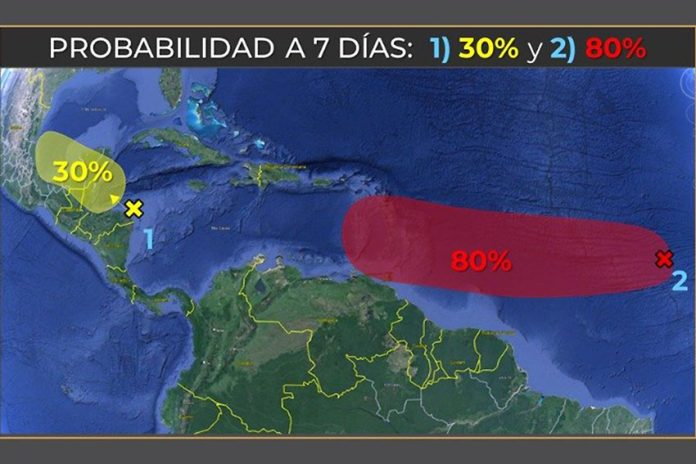Already battered by more than a week of stormy weather, Cancún and the rest of the Yucatán Peninsula are bracing for more heavy rain this weekend — and the strong possibility of a new tropical system in the Atlantic becoming a tropical storm early next week.
The tropical system could turn into a depression or a tropical storm this weekend as it reaches the southern Caribbean, according to the U.S. National Hurricane Center (NHC). Its path could then continue directly toward southeastern Mexico.

As of Thursday afternoon Mexico City time, the tropical system was located about 5,700 kilometers east of the Quintana Roo coast and was moving west at 24 to 32 km/h.
Mexico’s National Meteorological Service (SMN) gave the developing storm “a 60% probability of developing into a cyclone within 48 hours, and 80% [of doing so] within seven days.”
If that happens, the cyclone would be called Beryl, the second named storm of what’s expected to be a busy Atlantic storm season. Experts are saying that the season could see as many as 25 named tropical cyclones this year, 11 more than the seasonal average of 14.
Of that 25, between eight and 13 could turn into hurricanes.
The season’s first named storm — Tropical Storm Alberto — made landfall in the northeast state of Tamaulipas last Thursday. Although it quickly weakened into a tropical depression, Alberto’s wrath was felt over much of Mexico and southern Texas, with four deaths in Mexico being attributed to associated rains.
The Yucatán Peninsula felt some early effects from Alberto’s outer bands as it moved northwesterly. A different storm system then ravaged the peninsula over the next couple of days, causing extensive flooding and power outages. Parts of Mérida, the Yucatán state capital, were underwater as recently as Tuesday.
#Entérate Pirmero fue #Chetumal ahora así amaneció el paraíso #Cancún Calles y avenidas inundadas por las lluvias. pic.twitter.com/mj4Zn8plUf
— QuintanaRooNews (@quintanaroonews) June 18, 2024
Even before Tropical Storm Alberto made landfall in Mexico, Cancún’s streets were already experiencing flooding from rains associated with the storm.
Now a similar, smaller low-pressure system — different from the one currently located 5,700 km east of the Quintana Roo coast — that is associated with a tropical wave, is approaching Quintana Roo, bringing with it “widespread but disorganized shower and thunderstorm activity,” according to the NHC.
As of Thursday afternoon, the smaller system was much closer to the Yucatan, currently passing over the western Caribbean Sea, approximately 575 kilometers southeast of Chetumal, Quintana Roo. Its probability of developing into a cyclone was tabbed at 30% or less, but it is likely to bring intense rain to an already soaked area.
Already on Thursday morning and afternoon, there was scattered rain and showers, along with occasional thunderstorms and heavy fog in the south and southeast of Mexico. This area includes the Yucatán Peninsula, but similar conditions were expected up through Puebla and Mexico City and as far north as Querétaro.
Conagua also was predicting wind gusts of 30 to 50 km/h in Campeche, Yucatán and Quintana Roo, and lightning had been observed from Veracruz to Zacatecas to southern Baja California Sur.
The Riviera Maya News used the word “historic” to describe the recent torrential rains in Quintana Roo, noting that the state capital of Chetumal accumulated 518 mm in one seven-day period — the most rain it had seen in 72 years, according to Conagua director Érika Ramírez Méndez.
The paper also noted that “nearly every municipality [in Quintana Roo] experienced flooding, many more than once.” Many streets and homes were “under meters of water,” the paper added.
Jesús Almaguer Salazar, president of the Hotel Association of Cancún, Puerto Morelos and Isla Mujeres, said that tourist properties took an economic hit, mainly due to many employees not being able to report for work. He said the hotels have been accommodating, but the employee absences have hurt.
Quintana Roo Governor Mara Lezama reported that 1,100 people affected by the storm had registered for assistance in Chetumal and Bacalar. Some suffered flood damage to their homes, and others were affected by blockades that were set up due to rising water levels.
She said the response included the allocation of 37 million pesos (US $2 million), which includes 18 million pesos for the delivery of household goods, 5.5 million pesos for repairs and 2 million pesos for small businesses.
The governor also said there was no impact on tourism and that all the airports in the state remained open. Even on Holbox Island, she added, tourist activity retained “normality” despite the need to use bilge pumps to drain the rising waters on the island.
With reports from CNN Español, Riviera Maya News and El Economista
